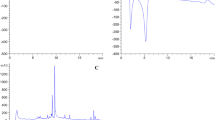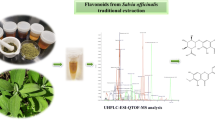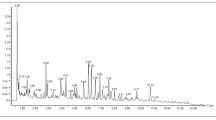Abstract
Citrus by-products are an important source of bioactive constituents, such as organic acids and phenolic compounds, with health promoting and nutritive properties. To increase our knowledge about this topic, the aim of the present study was to undertake a comprehensive characterization and quantification of major bioactive compounds in Citrus limon by-product dried powder (CBP) proceeding from a Tunisian company using reversed-phase high performance liquid chromatography (RP-HPLC) coupled to electrospray ionization time-of-flight mass spectrometry (ESI-TOF–MS) operating in negative ion mode. Physicochemical properties and the antioxidant activity of CBP were also assessed. As a result, 38 phenolic compounds including 6 phenolic acid derivatives, and 32 flavonoids were characterized and quantified. This work was complemented by the detection of 2 organic acids. To the best of our knowledge, 6 phenolic compounds have not previously been recorded in CBP. In this regard, the main flavonoids in CBP were the flavanones hesperetin 7-O-rutinoside, eriodictyol 7-O-rutinoside, and hesperetin 7-O-neohesperidoside followed by the flavones diosmin. Moreover, the dimer of caffeic acid-O-hexoside was the major phenolic acid. In addition, these results suggested that the extract obtained from CBP had an interesting antioxidant activity comparable with synthetic antioxidants and showed also high amounts of dietary fiber, protein, total sugars, and carotenoids. Finally, the results obtained in this work confirmed that the CBP is a good source of bioactive compounds and the isolation of antioxidant nutraceuticals could be an advantageous way to revalorize these by-products for potential use as dietary additives in functional foods and cosmetics as well as in pharmaceutical industry.



Similar content being viewed by others
References
Gif (2015) nd www.Groupement Interprofessionnel des fruits- Tunisie- Agrumes les différentes variétés d’agrumes. htm
Casquete R, Castro SM, Martín A, Ruiz-Moyano S, Saraiva JA, Córdoba MG, Teixeira P (2015) Evaluation of the effect of high pressure on total phenolic content, antioxidant and antimicrobial activity of Citrus peels. Innov Food Sci Emerg Tech 31:37–44
Mirzaei-Aghsaghali A, Maheri-Sis N (2008) Nutritive value of some agro-industrial by-products for ruminants—a review. World J Zool 3:40–46
Chau CF, Huang YL (2003) Comparison of the chemical composition and physicochemical properties of different fibers prepared from the peel of Citrus sinensis L. Cv. Liucheng. J Agric Food Chem 51:2615–2618
Llorach R, Espín JC, Tomás-Barberán FA, Ferreres F (2003) Valorization of cauliflower (Brassica oleracea L. var. botrytis) by-products as a source of antioxidant phenolics. J Agric Food Chem 51:2181–2187
García-Salas P, Gómez-Caravaca AM, Arráez-Román D, Segura-Carretero A, Guerra-Hernández E, García-Villanova B, Fernández-Gutiérrez A (2013) Influence of technological processes on phenolic compounds, organic acids, furanic derivatives, and antioxidant activity of whole-lemon powder. Food Chem 141:869–878
Lauro MR, Crasci L, Carbone C, Aquino RP, Panico AM, Puglisi G (2015) Encapsulation of a citrus by-product extract: development, characterization and stability studies of a nutraceutical with antioxidant and metalloproteinases inhibitory activity LWT-Food. Sci Technol 62:169–176
Kaur J, Kaur G (2015) An insight into the role of citrus bioactives in modulation of colon cancer. J Funct Foods 13:239–261
Nakajima VM, Macedo GA, Macedo JA (2014) Citrus bioactive phenolics: role in the obesity treatment. LWT-Food Sci Technol 59:1205–1212
Ha SK, Park HY, Eom H, Kim Y, Choi I (2012) Narirutin fraction from citrus peels attenuates LPS-stimulated inflammatory response through inhibition of NF-κB and MAPKs activation. Food Chem Toxicol 50:3498–3504
Benavente-Garcia O, Castillo J (2008) Update on uses and properties of citrus flavonoids: new findings in anticancer, cardiovascular, and anti-inflammatory activity. J Agric Food Chem 56:6185–6205
Senevirathne M, Jeon YJ, Ha JH, Kim SH (2009) Effective drying of citrus by-product by high speed drying: a novel drying technique and their antioxidant activity. J Food Eng 92:157–163
Uckoo RM, Jayaprakasha GK, Nelson SD, Patil BS (2011) Rapid simultaneous determination of amines and organic acids in citrus using high-performance liquid chromatography. Talanta 83:948–954
Pereira DM, Valentãa P, Andrade PB (2009) Organic acids of plants and mushrooms: are they antioxidants? Funct Plant Sci Biotechnol Glob Sci Books 3:103–113
Stahl W, Sies H (2003) Antioxidant activity of carotenoids. Mol Aspects Med 24:345–351
Karabagias IK, Louppis AP, Karabournioti S, Kontakos S, Papastephanou C, Kontominas MG (2017) Characterization and geographical discrimination of commercial Citrus spp. honeys produced in different Mediterranean countries based on minerals, volatile compounds and physicochemical parameters, using chemometrics. Food Chem 217:445–455
Brito A, Ramirez JE, Areche C, Sepúlveda B, Simirgiotis MJ (2014) HPLC-UV-MS profiles of phenolic compounds and antioxidant activity of fruits from three Citrus species consumed in northern Chile. Molecules 19:17400–17421
Ledesma-Escobar CA, Priego-Capote F, De Castro MDL (2016) Effect of sample pretreatment on the extraction of lemon (Citrus limon) components. Talanta 153:386–391
Zhao P, Duan L, Guo L, Dou LL, Dong X, Zhou P, Li P, Liu EH (2015) Chemical and biological comparison of the fruit extracts of Citrus wilsonii Tanaka and Citrus medica L. Food Chem 173:54–60
Scalbert A, Andres-Lacueva C, Arita M, Kroon P, Manach C, Urpi-Sarda XM, Wishart D (2011) Databases on food phytochemicals and their health-promoting effects. J Agric Food Chem 59:4331–4348
Guimarães R, Barros L, Barreira JCM, Sousa MJ, Carvalho AM, Ferreira ICFR (2010) Targeting excessive free radicals with peels and juices of citrus fruits: grapefruit, lemon, lime and orange. Food Chem Toxicol 48:99–106
Hotha KK, Patel T, Roychowdhury S, Subramania V (2014) Development of better-quality assay method for the citric acid and sodium citrate in ophthalmic/oral solutions and their application to deformulation studies. Am J Anal Chem 5:1249–1260
Cesquini M, Stoppa GR, Prada PO, Torsoni AS, Romanatto T, Souza A, Saad MJ, Velloso LA, Torsoni MA (2008) Citrate diminishes hypothalamic acetyl-CoA carboxylase phosphorylation and modulates satiety signals and hepatic mechanisms involved in glucose homeostasis in rats life. Sci 82:1262–1271
Abbès F, Bouaziz MA, Blecker C, Masmoudi M, Attia H, Besbes S (2011) Date syrup: effect of hydrolytic enzymes (pectinase/cellulase) on physicochemical characteristics, sensory and functional properties. LWT-Food Sci Technol 44:1827–1834
Yaich H, Garna H, Besbes S, Paquot M, Blecker C, Attia H (2011) Chemical composition and functional properties of Ulva lactuca seaweed collected in Tunisia. Food Chem 128:895–901
McConnell AA, Eastwood MA, Mitchell WD (1974) Physical characteristics of vegetable foodstuffs that could influence bowel function. J Sci Food Agr 25:1457–1464
Ferrer I, Garcia-Reyes JF, Mezcua M, Thurman EM, Fernández-Alba AR (2005) Multi-residue pesticide analysis in fruits and vegetables by liquid chromatography–time-of-flight mass spectrometry. J Chromatogr A 1082:81–90
Gargouri B, Ammar S, Zribi A, Ben Mansour A, Bouaziz M (2013) Effect of growing region on quality characteristics and phenolic compounds of chemlali extra-virgin olive oils. Acta Physiol Plant 35:2801–2812
Bouaziz M, Fki I, Jemai H, Ayadi M, Sayadi S (2008) Effect of storage on refined and husk olive oils composition: stabilization by addition of natural antioxidants from Chemlali olive leaves. Food Chem 108:253–262
Rigane G, Bouaziz M, Sayadi S, Ben Salem R (2012) Identification and characterization of a new iridoid compound from two-phase Chemlali olive pomace. Eur Food Res Technol 234:1049–1054
O’Shea N, Ktenioudaki A, Smyth TP, McLoughlin P, Doran L, Auty MAE, Arendt E, Gallagher E (2015) Physicochemical assessment of two fruit by-products as functional ingredients: apple and orange pomace. J Food Eng 153:89–95
Letaief H, Zemni H, Mliki A, Chebil S (2016) Composition of Citrus sinensis (L.) Osbeck cv «Maltaise demi-sanguine» juice. A comparison between organic and conventional farming. Food Chem 194:290–295
Marín FR, Soler-Rivas C, Benavente-García O, Castillo J, Pérez-Alvarez JA (2007) By-products from different citrus processes as a source of customized functional fibres. Food Chem 100:736–741
Ghanem N, Mihoubi D, Kechaou NNB (2012) Microwave dehydration of three citrus peel cultivars: effect on water and oil retention capacities, color, shrinkage and total phenols content. Ind Crops Prod 40:167–177
Lario Y, Sendra E, Garcı J, Fuentes C, Sayas-Barberá E, Fernández-López J, Pérez-Alvarez JA (2004) Preparation of high dietary fiber powder from lemon juice by-products. Innov Food Sci Emerg Technol 5:113–117
Yoo KM, Moon B (2016) Comparative carotenoid compositions during maturation and their antioxidative capacities of three citrus varieties. Food Chem 196:544–549
Xu G, Liu D, Chen J, Ye X, Ma Y, Shi J (2008) Juice components and antioxidant capacity of citrus varieties cultivated in China. Food Chem 106:545–551
Ammar S, Contreras MdM, Belguith-Hadrich O, Bouaziz M, Segura-Carretero A (2015) New insights into the qualitative phenolic profile of Ficus carica L. fruits and leaves from Tunisia using ultra-high-performance liquid chromatography coupled to quadrupole-time-of-flight mass spectrometry and their antioxidant activity. RSC Adv 5:20035–20050
Amakura Y, Yoshimura M, Ouchi K, Okuyama S, Furukawa Y, Yoshida T (2013) Characterization of constituents in the peel of Citrus kawachiensis (Kawachibankan). Biosci Biotechnol Biochem 77:1977–1980
Gómez-Romero M, Segura-Carretero A, Fernández-Gutiérrez A (2010) Metabolite profiling and quantification of phenolic compounds in methanol extracts of tomato fruit. Phytochem 71:1848–1864
Gouveia S, Castilho PC (2011) Antioxidant potential of Artemisia argentea L’Hér alcoholic extract and its relation with the phenolic composition. Food Res Int 44:1620–1631
Gouveia S, Castilho PC (2011) Characterisation of phenolic acid derivatives and flavonoids from different morphological parts of Helichrysum obconicum by a RP-HPLC–DAD-(-)–ESI-MSn method. Food Chem 129:333–344
Ledesma-Escobar CA, Priego-Capote F, Luque de Castro MD (2015) Characterization of lemon (Citrus limon) polar extract by liquid chromatography–tandem mass spectrometry in high resolution mode. J Mass Spectrom 50:1196–1205
Matsubara Y, Kumamoto H, Iizuka Y, Murakami T, Okamoto K, Miyake H, Yokoi K (1985) Structure and hypotensive effect of flavonoid glycosides in Citrus unshiu peelings. Agric Biol Chem 49:909–914
Rodríguez-Rivera MP, Lugo-Cervantes E, Winterhalter P, Jerz G (2014) Metabolite profiling of polyphenols in peels of Citrus limetta Risso by combination of preparative high-speed countercurrent chromatography and LC–ESI–MS/MS. Food Chem 158:139–152
Abad-García B, Garmón-Lobato S, Berrueta LA, Gallo B, Vicente F (2012) On line characterization of 58 phenolic compounds in Citrus fruit juices from Spanish cultivars by high-performance liquid chromatography with photodiode-array detection coupled to electrospray ionization triple quadrupole mass spectrometry. Talanta 99:213–224
Esaki S, Kamiya S, Konishi F (1975) Synthesis and taste of some dihydrochalcone glycosides. Agric Biol Chem 39:1385–1975
Russo M, Bonaccorsi I, Torre G, Sarò M, Dugo P, Mondello L (2014) Underestimated sources of flavonoids, limonoids and dietary fibre: availability in lemon’s by-products. J Funct Foods 9:18–26
Zhang M, Duan C, Zang Y, Huang Z, Liu G (2011) The flavonoid composition of flavedo and juice from the pummelo cultivar (Citrus grandis (L.) Osbeck) and the grapefruit cultivar (Citrus paradisi) from China. Food Chem 129:1530–1536
Nayak B, Dahmoune F, Moussi K, Remini H, Dairi S, Aoun O, Khodir M (2015) Comparison of microwave, ultrasound and accelerated-assisted solvent extraction for recovery of polyphenols from Citrus sinensis peels. Food Chem 187:507–516
Corradini C, Borromei C, Cavazza A, Merusi C, De Rossi A, Nicoletti I (2009) Determination of flavanones in Citrus byproducts and nutraceutical products by a validated RP-HPLC method. J Liq Chromatogr Relat Technol 32:1448–1462
Spínola V, Pinto J, Castilho PC (2015) Identification and quantification of phenolic compounds of selected fruits from Madeira Island by HPLC-DAD–ESI-MSn and screening for their antioxidant activity. Food Chem 173:14–30
Acknowledgements
This research was partially supported by grants from the Ministère de l’Enseignement Supérieur et de la Recherche Scientifique; Agence Nationale de la Promotion de la Recherche Scientifique (Tunisia) under the funded MOBIDOC device by the European Union under the PASRI program administered by the ANPR, and the Erasmus Mundus—Al Idrisi II (2013/S 101/545819). The author Vito Verardo thanks the Spanish Ministry of Economy and Competitiveness (MINECO) for “Ramon y Cajal” contract. They also would like to thank Miss Ibtissem ben Hammouda for her help in the statistical analysis.
Author information
Authors and Affiliations
Corresponding author
Ethics declarations
Conflict of interest
The authors declare that they have no conflict of interest.
Compliance with ethics requirements
This article does not contain any studies with human or animal subjects.
Rights and permissions
About this article
Cite this article
Gargouri, B., Ammar, S., Verardo, V. et al. RP-HPLC–DAD-ESI-TOF–MS based strategy for new insights into the qualitative and quantitative phenolic profile in Tunisian industrial Citrus Limon by-product and their antioxidant activity. Eur Food Res Technol 243, 2011–2024 (2017). https://doi.org/10.1007/s00217-017-2904-4
Received:
Revised:
Accepted:
Published:
Issue Date:
DOI: https://doi.org/10.1007/s00217-017-2904-4




